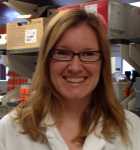AACR, Author Interviews, Melanoma, Wistar / 20.04.2015
PIM Kinase Inhibitors May Offer New Melanoma Therapeutic Target
 MedicalResearch.com Interview with:
Adina Vultur, Ph.D.
Staff Scientist
Meenhard Herlyn Laboratory
Melanoma Research Center
The Wistar Institute, Philadelphia
Medical Research: What is the background for this study? What are the main findings?
Dr. Vulture: Our goal was to identify new drugs with anti-melanoma activity but with minor effects on normal cells. We screened structurally distinct kinase inhibitors first, against multiple cell lines and normal cells, and identified the organometallic compound SM200 as being the most effective and selective molecule, capable of halting melanoma cell growth and invasion. Further characterization of SM200 indicated that PIM kinases are highly inhibited by this compound compared to other targets. We then confirmed the contribution of PIM kinases to melanoma pathobiology by knockdown studies and by using a clinically available PIM-inhibitor. Encouraging results with PIM kinase inhibition in multiple melanoma models including xenografts suggests that this could be a useful strategy against melanoma.
(more…)
MedicalResearch.com Interview with:
Adina Vultur, Ph.D.
Staff Scientist
Meenhard Herlyn Laboratory
Melanoma Research Center
The Wistar Institute, Philadelphia
Medical Research: What is the background for this study? What are the main findings?
Dr. Vulture: Our goal was to identify new drugs with anti-melanoma activity but with minor effects on normal cells. We screened structurally distinct kinase inhibitors first, against multiple cell lines and normal cells, and identified the organometallic compound SM200 as being the most effective and selective molecule, capable of halting melanoma cell growth and invasion. Further characterization of SM200 indicated that PIM kinases are highly inhibited by this compound compared to other targets. We then confirmed the contribution of PIM kinases to melanoma pathobiology by knockdown studies and by using a clinically available PIM-inhibitor. Encouraging results with PIM kinase inhibition in multiple melanoma models including xenografts suggests that this could be a useful strategy against melanoma.
(more…)



















